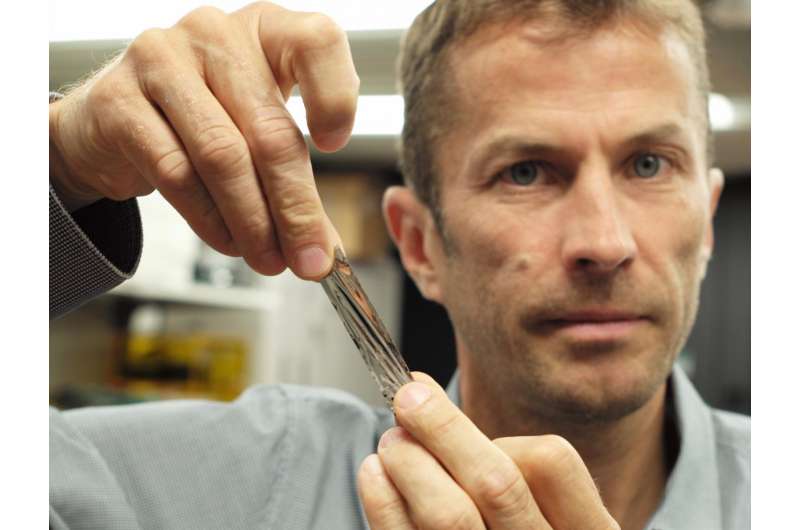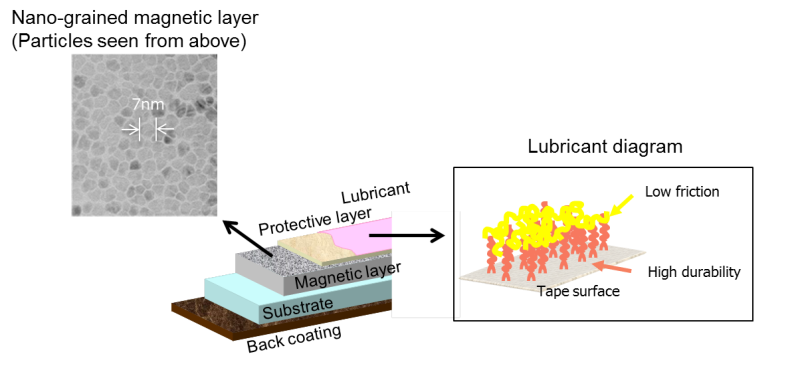Team sets new record for magnetic tape storage—makes tape competitive for cloud storage

Research scientists have achieved a new world record in tape storage – their fifth since 2006. The new record of 201 Gb/in2 (gigabits per square inch) in areal density was achieved on a prototype sputtered magnetic tape developed by Sony Storage Media Solutions. The scientists presented the achievement today at the 28th Magnetic Recording Conference (TMRC 2017) here.
Tape storage is currently the most secure, energy efficient and cost-effective solution for storing enormous amounts of back-up and archival data, as well as for new applications such as Big Data and cloud computing.
This new record areal recording density is more than 20 times the areal density used in current state of the art commercial tape drives such as the IBM TS1155 enterprise tape drive, and it enables the potential to record up to about 330 terabytes (TB) of uncompressed data on a single tape cartridge that would fit in the palm of your hand.
Assuming the same format overheads as the TS1155 format and taking into account the 6.4% increase in tape length enabled by the thinner demo tape. A TS1155 JD cartridge, can hold 15 TB of uncompressed data in a 4.29 in. x 4.92 in. x 0.96 in. (109.0 mm x 125 mm x 24.5 mm) form factor.
330 terabytes of data are comparable to the text of 330 million books, which would fill a bookshelf that stretches slightly beyond the northeastern to the southwestern most tips of Japan.
Magnetic tape data storage is currently experiencing a renaissance. With this achievement, IBM scientists demonstrate the viability of continuing to scale the tape roadmap for another decade.
"Tape has traditionally been used for video archives, back-up files, replicas for disaster recovery and retention of information on premise, but the industry is also expanding to off-premise applications in the cloud," said IBM Fellow Evangelos Eleftheriou. "While sputtered tape is expected to cost a little more to manufacture than current commercial tape that uses Barium ferrite (BaFe), the potential for very high capacity will make the cost per TB very attractive, making this technology practical for cold storage in the cloud."
To achieve 201 billion bits per square inch, IBM researchers developed several new technologies, including:
- Innovative signal-processing algorithms for the data channel, based on noise-predictive detection principles, which enable reliable operation at a linear density of 818,000 bits per inch with an ultra-narrow 48nm wide tunneling magneto-resistive (TMR) reader.
- A set of advanced servo control technologies that when combined enable head positioning with an accuracy of better than 7 nanometers. This combined with a 48nm wide (TMR) hard disk drive read head enables a track density of 246,200 tracks per inch, a 13-fold increase over a state of the art TS1155 drive.
- A novel low friction tape head technology that permits the use of very smooth tape media

IBM has been working closely with Sony Storage Media Solutions for several years, particularly on enabling increased areal recording densities. The results of this collaboration have led to various improvements in the media technology, such as advanced roll-to-roll technology for long sputtered tape fabrication and better lubricant technology, which stabilizes the functionality of the magnetic tape.
Many of the technologies developed and used in the areal density demonstrations are later incorporated into future tape products. Two notable examples from 2007 include an advanced noise predictive maximum likelihood read channel and first generation BaFe tape media.
IBM has a long history of innovation in magnetic tape data storage. Its first commercial tape product, the 726 Magnetic Tape Unit, was announced more than 60 years ago. It used reels of half-inch-wide tape that each had a capacity of about 2 megabytes. The areal density demonstration announced today represents a potential increase in capacity of 165,000,000 times compared with IBM's first tape drive product. This announcement reaffirms IBM's ongoing commitment and leadership in magnetic tape technology.
More information: Simeon Furrer et al. 201 Gb/in² Recording Areal Density on Sputtered Magnetic Tape, IEEE Transactions on Magnetics (2017). DOI: 10.1109/TMAG.2017.2727822
Journal information: IEEE Transactions on Magnetics
Provided by IBM


















